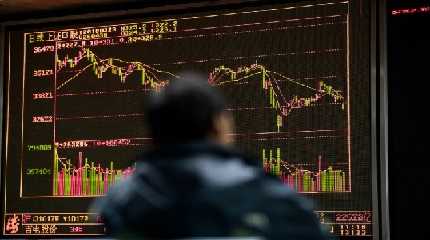
BEIJING (AP) — Chinese leaders face pressure to shore up sinking economic growth after Shanghai and other cities shut down to fight coronavirus outbreaks, threatening to disrupt global trade and manufacturing.
Growth slid to 1.3% over the previous quarter in the first three months of 2022, down from a 1.4% rate in last year’s final quarter, official data showed Monday. Compared with a year earlier, a measurement that can hide recent fluctuations, growth was 4.8%, up from 4% in the final quarter of 2021.
In a sign the slide might be deepening, March retail sales fell 3.5% from a year earlier.
This month’s activity is “set to be even worse,” Julian Evans-Pritchard of Capital Economics said in a report. “China’s economic performance is likely to remain lackluster in the near-term.”
The ruling Communist Party, which set a 5.5% growth target this year, already was trying to reverse a slump that started in mid-2021. Pressure mounted after last month’s surge in infections prompted Beijing to suspend access to Shanghai, a city of 25 million people, and other industrial centers.
“Further impacts from lockdowns are imminent,” Iris Pang of ING said in a report.
The slowdown hurts China’s trading partners by depressing demand for imported oil, food and consumer goods. Oil prices, which spiked after Russia’s attack on Ukraine, have eased on expectations Chinese consumption will weaken.
The ruling party promised tax refunds and other aid to businesses after tighter controls on use of debt triggered a slowdown in China’s vast real estate industry. Last week, Premier Li Keqiang, the No. 2 leader, called for quicker action to help entrepreneurs who generate China’s new jobs and wealth.
Forecasters say Beijing is using cautious, targeted stimulus instead of across-the-board spending, a strategy that will take longer to show results. Chinese leaders worry too much spending or bank lending might push up politically sensitive housing costs or corporate debt they worry is dangerously high.
Meanwhile, China faces more headwinds from a possible slowdown in the European Union, a major export market, due to Russia’s war on Ukraine and higher oil and gas prices, according to Rajiv Biswas of S&P Global Market Intelligence.
That would “hit China’s manufacturing export sector,” Biswas said in an email.
The flow of industrial goods has been disrupted by the suspension of access to Shanghai, home of the world’s busiest port, and other industrial cities including Changchun and Jilin in the northeast. Global automakers and other manufacturers have reduced or stopped production at Chinese factories.
The disruption “will weigh on activity in April and into May, if not longer,” Tommy Wu of Oxford Economics said in a report. That is “likely to have a significant impact on global supply chains.”
China’s latest infection numbers are relatively low, but Beijing is responding to its biggest outbreak since the 2020 start of the pandemic with a “zero-COVID” policy that aims to isolate every person who tests positive.
Consumer demand, an important economic engine, was dampened by a government appeal to the public to avoid traveling during February’s Lunar New Year holiday, normally a period of big spending on gifts, banquets and tourism.
Factory output rose 6.5% during the quarter over a year earlier. Investment in factories, real estate and other fixed assets increased 9.3%, possibly reflecting easier credit.
This quarter, retail sales might fall 5.5% from a year ago, while factory output contracts by 1.5%, according to Nomura economists Ting Lu, Jing Wang and Harrington Zhang.
“Global markets underestimate China’s growth slowdown,” which is “set to ripple to the rest of the world,” they said in a report.
Last week, regulators injected an extra 500 billion yuan ($80 billion) into the pool of money for lending by reducing the amount of deposits commercial banks are required to hold in reserve.
Shanghai has eased controls that confined most its people to their homes. But while some 6.6 million people were allowed to go outdoors, most businesses stayed closed.
The agency that runs the Shanghai port says operations are normal. But companies say the volume of cargo it handles has fallen.
Shanghai is so important that a full month’s shutdown will subtract 2% from China’s annual economic growth, according to Pang of ING.
“This loss will increase if the lockdown lasts longer,” Pang wrote.
Authorities also suspended access to Tianjin, a port and petrochemical center east of Beijing, and Shenzhen, a finance and tech hub near Hong Kong. Other cities have closed businesses, told residents to stay home if possible or imposed limits on movement.
Economists have warned spring planting by Chinese farmers who feed 1.4 billion people might be disrupted. That would hurt economic activity and boost demand for imported wheat and other food, potentially pushing up already high global prices.
China rebounded quickly from the pandemic in 2020, but activity weakened as tighter controls on borrowing by real estate developers hit construction, which supports millions of jobs.
Investors are waiting to see what happens to one of China’s biggest developers, Evergrande Group. It has struggled since last year to avoid defaulting on $310 billion owed to banks and bondholders.




